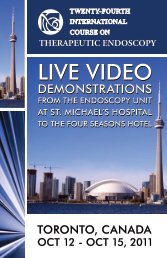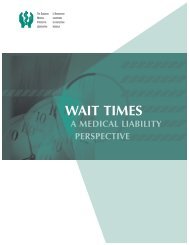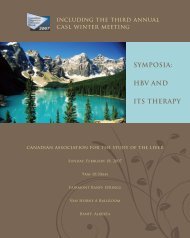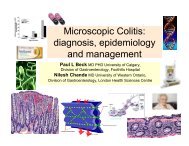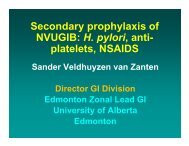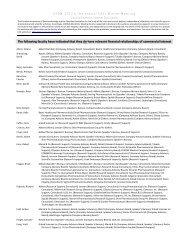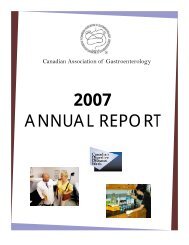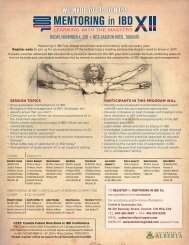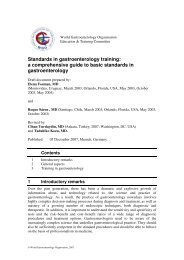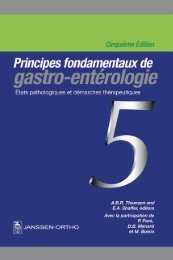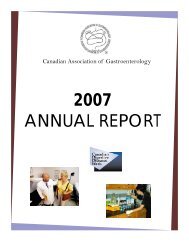- Page 2 and 3: 13 Le foie P. Paré Sections rédig
- Page 4 and 5: Le foie 555 le sang efférent vers
- Page 6 and 7: Le foie 557 FIGURE 2. Circulation e
- Page 8 and 9: Le foie 559 et des produits de dég
- Page 10 and 11: Le foie 561 (GSH) réduit et les au
- Page 12 and 13: Le foie 563 5. La famille des prot
- Page 14 and 15: Le foie 565 2.1.2 ICTÈRE L’ictè
- Page 16 and 17: Le foie 567 2.1.3 HÉPATOMÉGALIE A
- Page 18 and 19: Les techniques d’imagerie médica
- Page 20 and 21: Le foie 571 Globulines : Les hépat
- Page 22 and 23: Le foie 573 FIGURE 5. Image tomoden
- Page 24 and 25: TABLEAU 2. Indications de la biopsi
- Page 26 and 27: FIGURE 6. Approche pragmatique de l
- Page 28 and 29: Le foie 579 FIGURE 7. Concentration
- Page 30 and 31: Le foie 581 TABLEAU 5. Étude de la
- Page 32 and 33: Le foie 583 TABLEAU 6. Produits nat
- Page 34 and 35: Le foie 585 représente 90 % des 1
- Page 36 and 37: FIGURE 8. Élimination des médicam
- Page 38 and 39: Le foie 589 Les réactions hépatiq
- Page 40 and 41: TABLEAU 9. Substrats de certaines e
- Page 44 and 45: Le foie 595 Le type II est une affe
- Page 46 and 47: Le foie 597 adénovirus, virus de l
- Page 48 and 49: Le foie 599 personne peut se produi
- Page 50 and 51: Le foie 601 6.1.5 PRÉVENTION Dans
- Page 52 and 53: Le foie 603 FIGURE 11. Caractérist
- Page 54 and 55: 6.2.5 PRÉVENTION Il existe des mé
- Page 56 and 57: 6.3.4 TRAITEMENT On peut traiter l
- Page 58 and 59: Le foie 609 d’hépatite virale ai
- Page 60 and 61: Le foie 611 FIGURE 12. Hépatite l
- Page 62 and 63: Le foie 613 FIGURE 15. Nécrose sub
- Page 64 and 65: TABLEAU 18. Le score METAVIR pour d
- Page 66 and 67: FIGURE 17A. Hépatite chronique lé
- Page 68 and 69: TABLEAU 19. Rôle de l’anamnèse
- Page 70 and 71: Le foie 621 TABLEAU 20. Comparaison
- Page 72 and 73: FIGURE 19. Histoire naturelle d’u
- Page 74 and 75: Le foie 625 rapport coût-avantages
- Page 76 and 77: TABLEAU 26. Facteurs de risque de C
- Page 78 and 79: Le foie 629 FIGURE 21. Surveillance
- Page 80 and 81: FIGURE 22. Progrès dans le traitem
- Page 82 and 83: TABLEAU 30. Traitements de l’hép
- Page 84 and 85: TABLEAU 31. Différences entre hép
- Page 86 and 87: Le foie 637 FIGURE 23. Représentat
- Page 88 and 89: Le foie 639 cellules contenant les
- Page 90 and 91: Le foie 641 GGT pour déceler les e
- Page 92 and 93:
Le foie 643 pression portale. Chez
- Page 94 and 95:
Le foie 645 production de TNF- éta
- Page 96 and 97:
Le foie 647 diminuent avec l’infi
- Page 98 and 99:
et le stress oxydatif. Un certain n
- Page 100 and 101:
Le foie 651 FIGURE 25. Pathogenèse
- Page 102 and 103:
cette réaction à un médicament n
- Page 104 and 105:
Le foie 655 impossible de distingue
- Page 106 and 107:
Le foie 657 céruloplasmine bas et
- Page 108 and 109:
Le foie 659 Chez l’homozygote, le
- Page 110 and 111:
TABLE 35. Principales causes de la
- Page 112 and 113:
transporteurs pourraient être resp
- Page 114 and 115:
TABLEAU 37. Comparaison de la cirrh
- Page 116 and 117:
12.5 Prise en charge du patient att
- Page 118 and 119:
FIGURE 29. Foie cirrhotique. Le foi
- Page 120 and 121:
Le foie 671 FIGURE 30. Cirrhose mix
- Page 122 and 123:
Le foie 673 grave hépatopathie. La
- Page 124 and 125:
TABLEAU 40. Causes d’hypertension
- Page 126 and 127:
TABLEAU 41. Sites courants de forma
- Page 128 and 129:
TABLEAU 42. Comparaison de la gastr
- Page 130 and 131:
Le foie 681 FIGURE 33. Vue à l’e
- Page 132 and 133:
Le foie 683 mésentérique, comme l
- Page 134 and 135:
Le foie 685 des communications art
- Page 136 and 137:
FIGURE 34. Physiopathologie de la f
- Page 138 and 139:
TABLEAU 43. Indications de la ponct
- Page 140 and 141:
TABLEAU 45. Utilisation par paliers
- Page 142 and 143:
Le foie 693 être spectaculairement
- Page 144 and 145:
TABLEAU 46. Micro-organismes pouvan
- Page 146 and 147:
Le foie 697 ces patients. Toutefois
- Page 148 and 149:
TABLEAU 47. Établissement du grade
- Page 150 and 151:
Le foie 701 un examen neurologique
- Page 152 and 153:
Le foie 703 alimentaires à 20 g/jo
- Page 154 and 155:
Le foie 705 (TFG), tandis que, dans
- Page 156 and 157:
TABLEAU 49. Critère de diagnostic
- Page 158 and 159:
Le foie 709 attribuables à une hé
- Page 160 and 161:
TABLEAU 51. Contre-indications de l
- Page 162 and 163:
Le foie 713 À l’hôpital génér
- Page 164 and 165:
Le foie 715 18.8 Immunosuppression
- Page 166 and 167:
Le foie 717 Antagonistes du récept
- Page 168 and 169:
TABLEAU 53. Résultats des greffes
- Page 170 and 171:
Le foie 721 19.1 Tumeurs bénignes
- Page 172 and 173:
d’hypertension portale, avec test
- Page 174 and 175:
Le foie 725 focale supérieure à 2
- Page 176 and 177:
FIGURE 39. Investigation d’une ma
- Page 178 and 179:
20. HÉPATOPATHIE DURANT LA GROSSES
- Page 180 and 181:
Le foie 731 vésiculaire de la vulv
- Page 182 and 183:
Le foie 733 et l’ictère est rare
- Page 184 and 185:
Le foie 735 à moins que le fœtus
- Page 186 and 187:
FIGURE 41. Schéma de la circulatio
- Page 188 and 189:
Le foie 739 de sortie sanguine du f
- Page 190 and 191:
Le foie 741 splénomégalie. On peu
- Page 192 and 193:
Le foie 743 Fried MW, Shiffman ML,
- Page 194 and 195:
Le foie 745 Section 15 Ascite et p
- Page 196 and 197:
Le foie 747 Section 2. Approche des
- Page 198 and 199:
Le foie 749 2. Élaborer une démar
- Page 200 and 201:
4. Savoir traiter les formes commun
- Page 202 and 203:
Le foie 753 5. Les complications de
- Page 204 and 205:
Le foie 755 8. Il est rare qu’un
- Page 206 and 207:
Le foie 757 3. On ne peut pas prés
- Page 208 and 209:
Le foie 759 Section 5. Hyperbilirub
- Page 210:
Le foie 761 Section 17. Syndrome h



